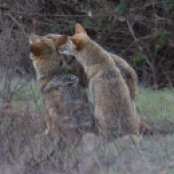I watched this coyote family playing together with abandon when a dog walker appeared in the distance in the park where these coyotes live. It was time for the coyote family to head into hiding. The two youngsters followed Dad, single file, to this location where they all sat down close together for a short time before ducking into some bushes.
At first what I thought was going on was that the two nine-month-old youngsters were indulging Dad: “Hey, we like you, Dad!” — one pup mouthed and licked Dad’s ear while the other one did the same to Dad’s snout! They were not soliciting food from their father — food solicitation occurs upon Dad’s return when he has been away hunting, not after a play session.
But as I watched, it suddenly occurred to me that there was probably something a little more subtle and selfish going on. The behavior brought to mind behavior I had detected before between siblings in another coyote family. It seems that the youngsters were actually vying for preferential parental attention and favoritism. Dad is to the left — and each coyote youngster was vying to sit next to him, exclusive of the other.
The youngster in back is actually squeezing her way between her sibling to the right, and Dad to the left, inserting herself into the coveted space next to Dad. But the other youngster does not budge. Of course, this youngster could have just sat on the other side, but her plan involved splitting Dad and the other sibling apart.
Doesn’t this happen in human families between very young children? It did in mine. Whomever gets to sit next to Mom or Dad has the prime position, and feels, whether true or not, that parental preference has been bestowed on him/her. If this rivalry, which is only subtle now, intensifies and plays itself out over the next few months, one of these youngsters will be forced out of the family pack by the other. As this happens, as far as I have seen, the one being forced out will generally carry its ears airplaned out to the sides and lowered.
































